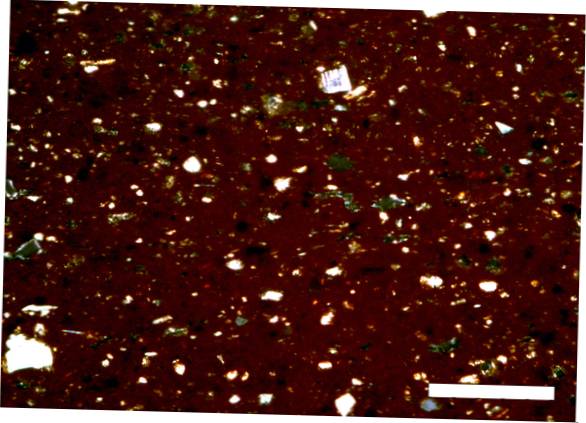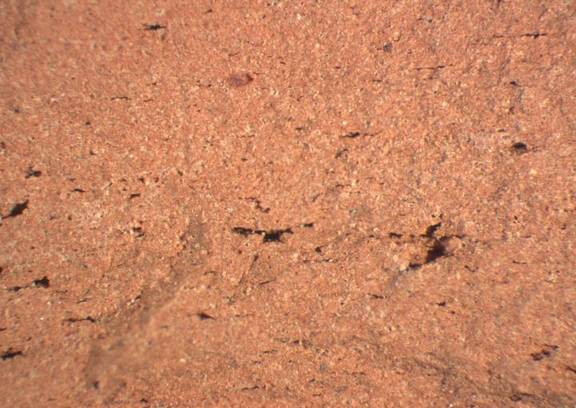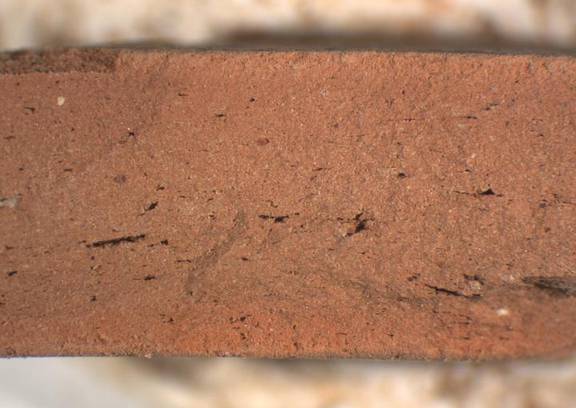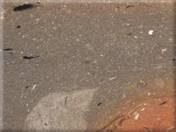

HIM-A-2, M 179/230, scale bar 0.2mm


HIM-A-2, M 179/230, scale bar 0.5mm


HIM-A-2, M 179/230, 25x


HIM-A-2, M 179/230, 16x


HIM-A-2, M 179/230, 8x
| | fabric description | | object data | | archaeometry | | petrography | | |
| fabric type |
HIM-A-2
|
| ware |
Transport Amphorae |
| supposed site of production |
Himera |
| certainty of arguments |
archaeometric: certain, archaeological: quite certain |
| visual excamination of fresh break |
Reddish-pinkish clay very fine and depurated with no visible inclusions exept for some rare cases of very small and whitish inclusions |
| colour of freshly broken section (munsell) |
5 YR 6/6 |
| texture of freshly broken surface |
fine |
| hardness |
hard |
| porosity |
void form: vughy; channel; void length: 0.04-1.00-1.59 (channel lenght max) |
| inclusions |
length: 0.04-0.16 |
| sorting |
well sorted silt |
| |
Inclusions
|
|
mica |
infrequent, very small size |
|
calciumcarbonate |
frequent, rounded; subangular, very spherical, whtiish, 0,04-0,16 |
|
carbonate pseudomorphoses |
infrequent, well rounded; rounded, spherical, white-yellowish, 0,04-0,16 |
| | fabric description | | object data | | archaeometry | | petrography | | |
| vessel form type |
Amphora
Western Greek, Gassner rim 7 |
| fragmentation |
rim |
| dimensions |
diameter: 13.6cm (rim); height: 7cm |
| surface description |
slipped
whitish slip 7.5 YR 8/1 only externerly |
| chronology of object |
Greek-Classic
420-409 BC |
| publication |
Bechtold et al. 2019, 9, fig. 6,1; Bechtold 2020, fig. 2,4; Montana et al. 2020, fig. 3,C-D |
| drawing |
 |
| |
Context Data
|
| site of discovery |
Himera
Necropoli Ovest |
| registration code of context |
W4431 |
| registration code of object |
W4431- HA17014 |
| | fabric description | | object data | | archaeometry | | petrography | | |
| applied method for sample analysis |
thin section, chemical analysis |
| analysis author |
Montana/Randazzo |
| sample taken |
February 2018, by Babette Bechtold, Institute of Classical Archaeology, Vienna University |
| sample no |
M 179/230 |
| status of sample |
whole sample available |
| | fabric description | | object data | | archaeometry | | petrography | | |
| sample number |
M 179/230 |
| inventory number |
transport amphora |
| analysis author |
Giuseppe Montana - Luciana Randazzo |
| email |
giuseppe.montana@unipa.it; luciana.randazzo@unical.it |
| institution |
giuseppe.montana@unipa.it; luciana.randazzo@unical.it:
|
| |
Inclusions Microstructure
|
| distribution |
homogeneous |
| packing |
low (3-10%) |
| size |
prevalent:
very fine (0.04-0.1mm)
common:
fine (0.1-0.2mm)
rare:
medium (0.2-0.5mm)
|
| roundness |
angular |
| sorting |
scarce-serial |
| maximum grain size |
0.3 |
| |
Mineral Inclusions
|
| prevalent |
Monocrystalline Quartz |
| common |
Polycrystalline Quartz, Muscovite |
| sporadic |
Orthoclase |
| rare |
Plagioclase |
| |
Newly Formed Phases
|
| sporadic |
secondary calcite |
| |
Other Compositional & Textural Features
|
| sporadic |
Microfossils, Micritic Clots |
| quartz grain prevailing roundness |
angular |
| |
Coating / Slipping
|
| thickness |
|
| conservation status |
|
| |
Texture
|
| homogenity |
moderately homogeneous patchy: sporadic |
| optical activity |
inactive |
| color |
|
| degree of sintering |
well sintered |
| |
Porosity
|
| abundance of voids/pores |
low (<10%) |
| orientation |
partial |
| prevalent |
tiny (<0.01mm), small (0.01-0.1mm), irregular, vesicular, cast |
| sporadic |
medium (0.1-1mm) |
| |
Composition
|
| clay composition |
ca-rich |
| |
Interpretation
|
| estimated firing temperature |
well fired |
| modelling of raw clay |
use of wheel |
| refinement of raw clay |
acceptable |
| refinement of temper |
sieved natural sand |
Cite this page as: FACEM - http://facem.at/m-179-230












 production
production
 sampling
sampling






